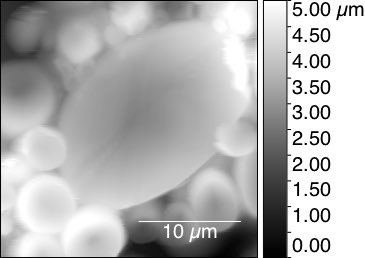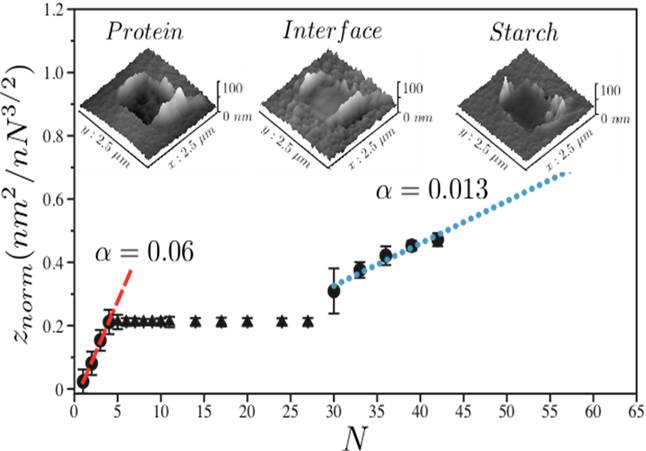Rechercher
Accueil > La Recherche > Axes & Equipes > Matière Molle & Verres > Equipe : Matière Molle > Thème : Matière molle pour l’agronomie et l’environnement
Structure, rheology and fracture of bio-polymers
publié le , mis à jour le
Structure, rheology and fracture of bio-polymers
We are investigating the structural and mechanical properties of natural products extracted from plants (wheat grain and proteins) or synthesized from plant biomass.
Mechanical behaviour of wheat endosperm
People involved : M. George
The yield and quality of products (food and non-food) obtained by crushing and sieving processes is a major challenge for the cereal industries. The influence of the microstructure and the mechanical properties of constituents and interfaces within a cereal grain on its fracturing behavior are yet not well-understood. Innovative techniques for mechanical measurements at the local scale using atomic force microscopy (nano-abrasion tests, contact resonance) are performed on different types of grain (mainly wheat), with carefully controlled genetics and growth conditions. These measurements allow for the first time to explore the mechanical behavior of the bio-polymer composite (gluten, starch) on the scale of the different phases and interphases that constitute it. On the basis of these new data, a granular model taking into account the microstructure and the properties of the different constituents and interfaces is developed allowing to simulate the fractionation behavior of a cereal grain and ultimately to orient the selection of more varieties for improved ability towards fractionating and biological tissues separation. (Collaboration V. Lullien-Pellerin, J-Y Delenne, UMR IATE, Montpellier)

Topography of the starchy endosperm of wheat grains performed through AFM

Abrasion depth vs. number of scan. The plot reveals the successive abrasion behavior of gluten, interface and starch. (Inserts) 3D AFM topography images which allow to measure the abraded depth (respectively for gluten, interface and starch)
Structuration of gluten proteins
People involved : J. Pincemaille (PhD), A. Banc, L. Ramos
Wheat storage proteins produce, upon hydration and mechanical stimuli, a unique viscoelastic basis, called gluten, used for processing a large variety of foodstuff. The various proteins constituting the gluten were identified and classified in two groups : gliadins and glutenins. Although their sequences and secondary structures were characterized, very few data exist concerning their supramolecular organization. The probably transient network formed should be at the origin the unique rheological properties of wheat dough. Our aim is to characterize the supramolecular organization of model wheat storage proteins as a function of hydration and shearing, in order to relate structural properties to their specific response to mechanical stress. Different model system implying purified proteins are investigated. We are currently studying model systems comprising controlled amounts of the two main proteins of gluten, glutenins and gliadins. We focus on the visco-elastic behavior near gelation. A large panel of static and dynamical scattering methods is used in order to elucidate the complex structure of the materials, and to link the structure to the unique visco-elastic properties of the materials (Collaboration Paul Menut, M-H Morel, UMR IATE, Montpellier).

Dispersions and gels made from various concentrations of an isolate of gluten proteins in water-ethanol.
Physical properties of bio-based hyperbranched polymers
People involved : L. Ramos
Hyperbranched polymers are a special type of dendritic materials and have as common features a high branching density as well as a globular and compact architecture. This unusual structure provides them with interesting properties such as a lower viscosity and a higher solubility than their linear analogues, in addition to their high functionality. Hyperbranched polymers are considered as suitable products for large scale applications and are widely used as additives, materials for encapsulation in a wide range of fields including paintings, coatings, and cosmetics or in the medical field. However, all the currently commercially available hyperbranched polymers are petroleum-based. The project aims at characterizing the structural and rheological properties of unique classes of hyperbranched polymer synthesized from biomass and functionalized at their periphery by charged and hydrophilic moieties in order to tune their properties in solution. (Collaboration with H. Cramail, LCPO, Bordeaux)








